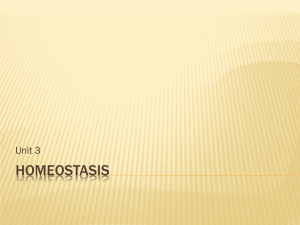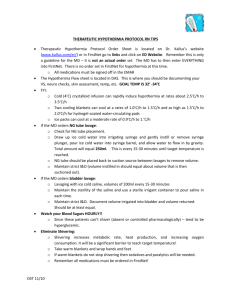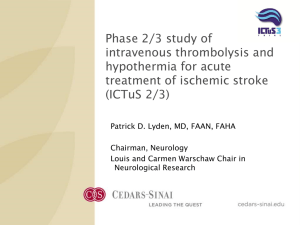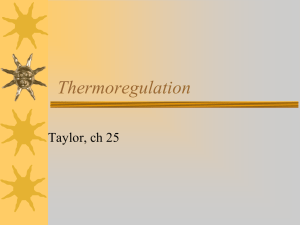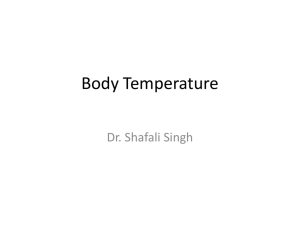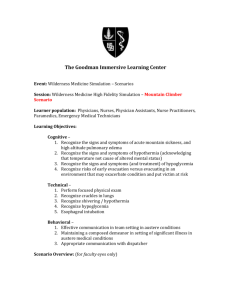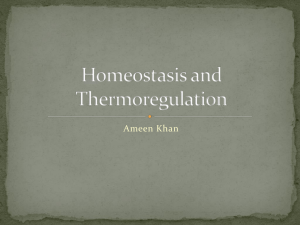Temperature and Homeostasis
advertisement
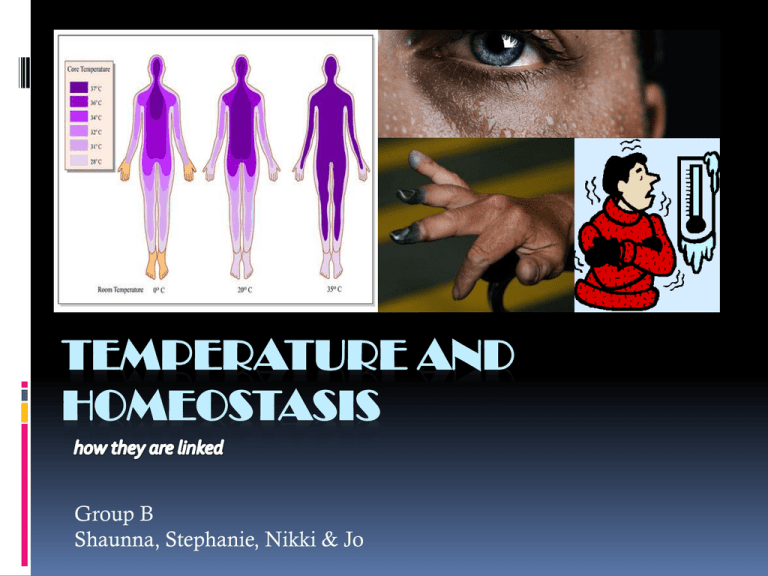
TEMPERATURE AND HOMEOSTASIS Group B Shaunna, Stephanie, Nikki & Jo What is Homeostasis? HOMEOSTASIS – noun the tendency of a system, the physiological system of higher animals, to maintain internal stability, owing to the coordinated response of its parts to any situation or stimulus tending to disturb its normal condition or function. The constant maintenance of your internal environment. Homeostasis is the overall system linked to many other systems that regulates our core temperature. Homeo = same Stasis = position The Greatest Balancing Act of all time The only consistent thing in our life is change. Homeostasis is responsible for maintaining our body at its optimum functioning level by responding to these constant changes – so without it we would die. Every time our body senses that we are “out of balance” with our regular temperature (37˚C) it will try and regain stability – like a pair of scales that is almost always balanced. The negative feedback system and temperature regulation A negative feedback system is a mechanism that a homoeotherm (warm blooded animal) uses to protect itself from the ever changing weather conditions of their environment no matter the temperature, for example a humans core body temperature should be at a constant 37 degrees C and these negative feedback mechanisms is what regulates this temperature which is our case is especially critical for our existence as this core temperature can only safely range two degrees without causing either hyperthermia or hypothermia, It is important to maintain a constant temperature so that living organisms can maintain healthy and regular operation. The negative feedback system and temperature regulation Temperature in mammals is detected by thermoreceptors in the skin and hypothalymus which is in the brain. Changes in temperature bring about nerve impulses from the brain to the muscles and glands which will bring about changes depending on whether it is hot or cold. Control center — where the messages are received from the receptors about change in the body's temperature then sending messages to effectors to change their function to correct the recognized change Effector — the muscle or organ that receives messages from the control center to change its function in order to correct the change of the body's internal conditions. Hormone — chemical the body produces to alter function or messages being sent Receptor — A structure that monitors the body's internal functions and conditions; detects changes in the body's internal environment, in this case is temperature. Set point — The range of normal functional values of an organ or structure which for a human body would be set at 37 degrees. Why do we shiver? We shiver in a response to low temperature, muscles contract & relax repeatedly, thus generating heat by friction & from metabolic reactions. When our core body temperature falls, the shivering reflex is triggered. Shivering is triggered in an attempt to avoid hypothermia, when our body temperature is lowered to dangerous levels, our muscles are encouraged to contract & expand quickly, thus resulting in a shiver. This causes more heat in the skeletal muscles to be produced to provide additional warmth to vital organs. Interesting fact: Whales do not shiver. They have an effective thermo regulatory system, which keeps their body temperature still; whether they are in warm, tropic waters or icy Arctic waters. Whales have a thick layer of blubber, (that can be up to 20 inches thick), this protects the whales from extreme temperatures. Piloerection- not just a funny name Erection of the hair of the skin. E.g. Piloerection of the hair on the arm causes it to "stand on end." It is begun when a stimulus (drop in temperature/a fright) causes a release from the (involuntary) nervous system which triggers tightening of muscles. The contractions which are triggered, raise the hair follicles & trap an insulating layer of still, warm air next to the skin. Sweating – a horrible stench or vital mechanism? Sweating is a negative feedback response when our core temperature rises over 37˚C • The hypothalamus senses that the body is too hot via neuron impulse. • Sweat glands underneath your skin activate releasing sweat •Sweat evaporates off •Ending with cool sensation Negative Feedback Response Hypothermia – how does it happen? Core body temperature drops to 35˚C or below. Body tries to stay warm. (shivering) Body stops shivering to conserve energy. Blood just starts being pumped to vital organs. Blood doesn’t go to parts of the body that it doesn’t classify as ‘important’ (fingers, toes) and they eventually die. This is called Frostbite. Hypothermia – Symptoms Feeling cold Shivering Loss of control of fine motor muscles (fingers etc) Feeling lethargic (very tired) Difficulty breathing Shivering stops Breathing slows down Coma Death The nervous system and temperature regulation -The command centre of the nervous system is the brain - The part of the brain that controls homeostasis is - When receptors (e.g. skin receptors) called the sense a change or deviation they send a hypothalamus message to the hypothalamus , which then sends chemical and electrical messages to that part of the body to re-establish normality. What you should have learned by now – key terms Homeostasis is the constant maintenance of the internal environment. In temperature regulation, the skin receptors pick up change in the temperature in the external environment, the hypothalamus detects the change and then responds with a negative feedback mechanism (e.g. shivering, sweating) to ensure the body returns to its norm. Sweating – Is a negative feedback response and occurs when the hypothalamus senses the body is too hot. Hypothermia – Also a negative feedback response but is life threatening as the body loses more heat then it can generate allowing core body temperature to drop below 35˚C. Shivering - is initiated due to a drop in temperature, it causes muscles to contract and relax frequently. It is triggered in an attempt to avoid hypothermia, our skeletal muscles produce extra heat for our organs. Piloerection - Is erection of the hair. Stimulus triggers contractions of muscles. The contractions cause hair follicles to rise, and trap a warm, still layer of insulating air next to the skin. “Hairs stand on end.” Bibliography http://pespmc1.vub.ac.be/HOMEOSTA.html http://upload.wikimedia.org/wikipedia/commons/f/f1/2003-09-17_Goose_bumps.jpg http://fog.ccsf.cc.ca.us/~mmalacho/physio/oll/Lesson1/hstasis.html http://dictionary.reference.com/browse/homeostasis http://farm4.static.flickr.com/3173/3029642097_33c42e073e.jpg http://www.biology-online.org/4/4_temperature_regulation.htm World of teaching. "What mechanisms are there to cool the body down?" Web. 24 July 2009. Better Health Channel. "Hypothermia." Web. 24 July 2009. Yahoo Answers. "Why does sweat smell? Why do we sweat from our armpits?" Web. 28 July 2009. http://www.biology-online.org/4/4_temperature_regulation.htm http://science.jrank.org/pages/3365/Homeostasis.html#ixzz0MWUz8dBb
